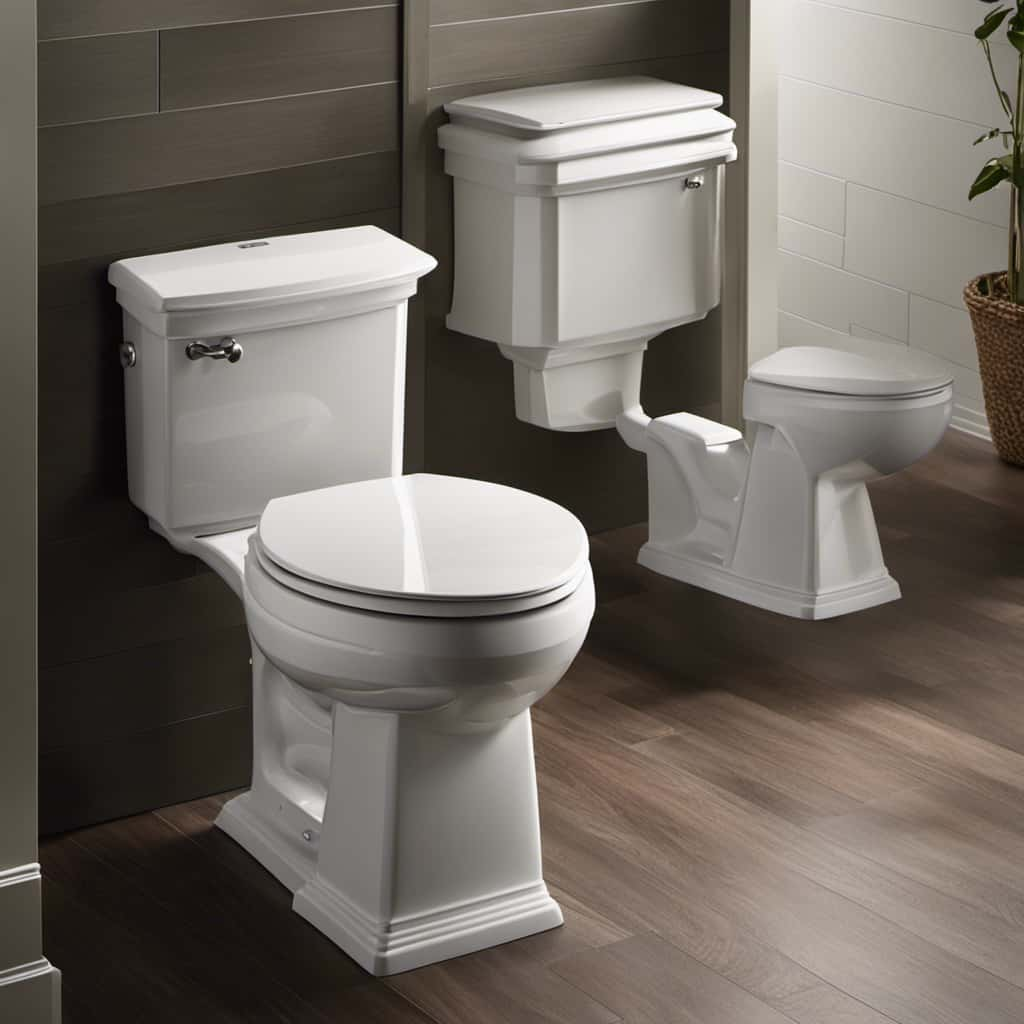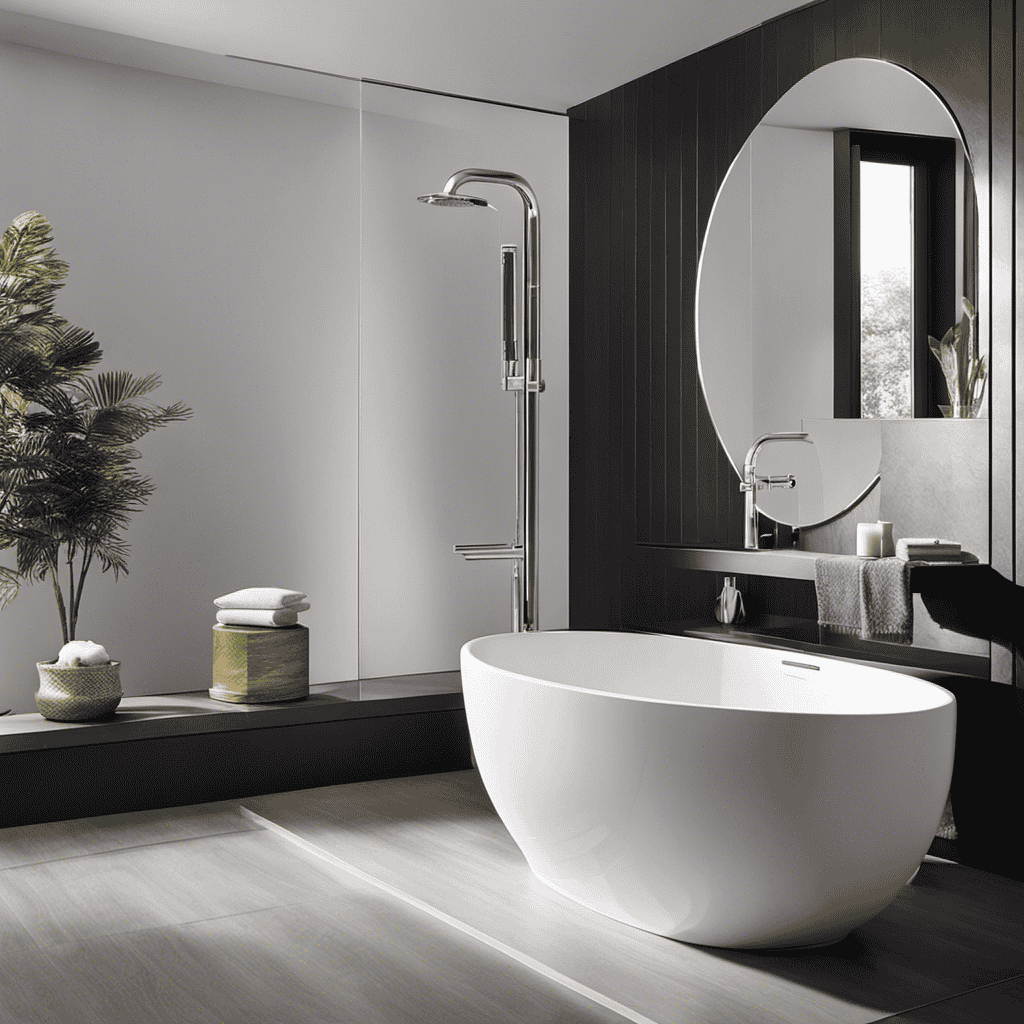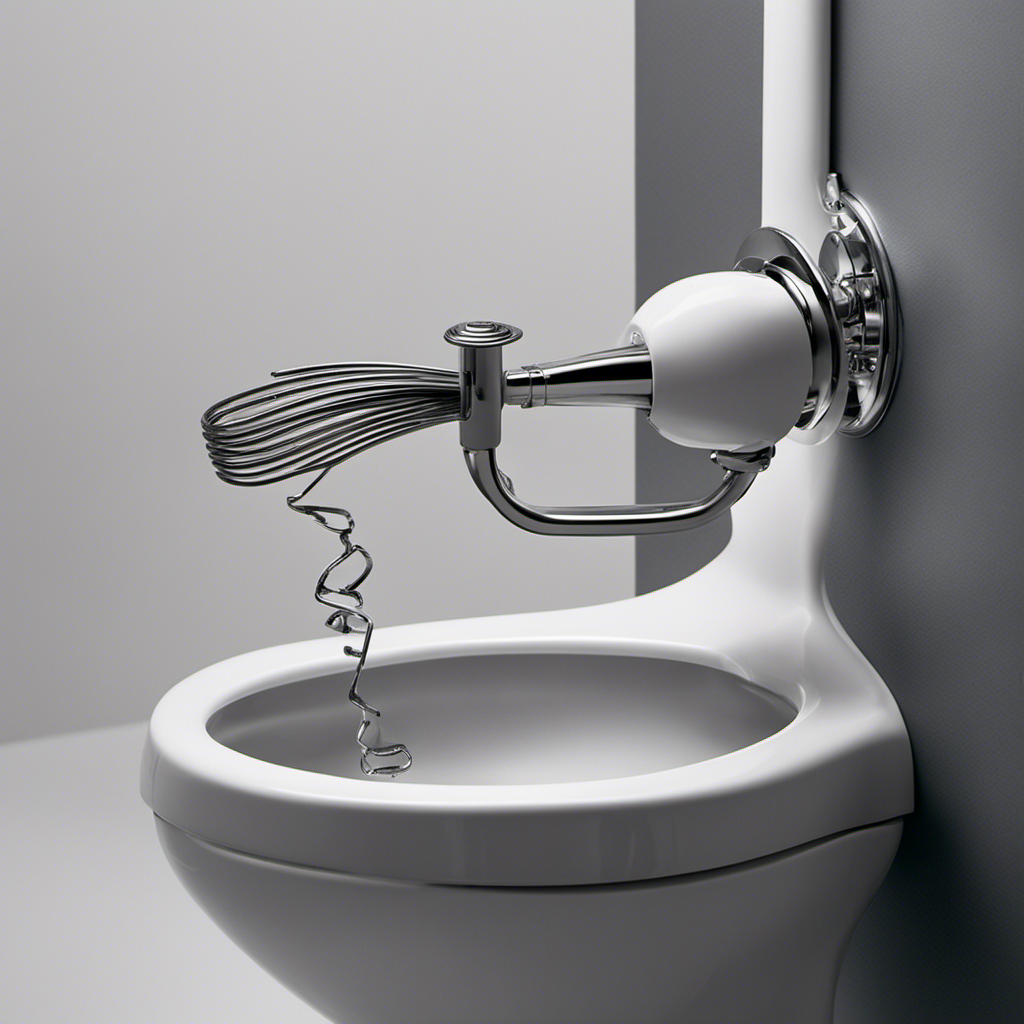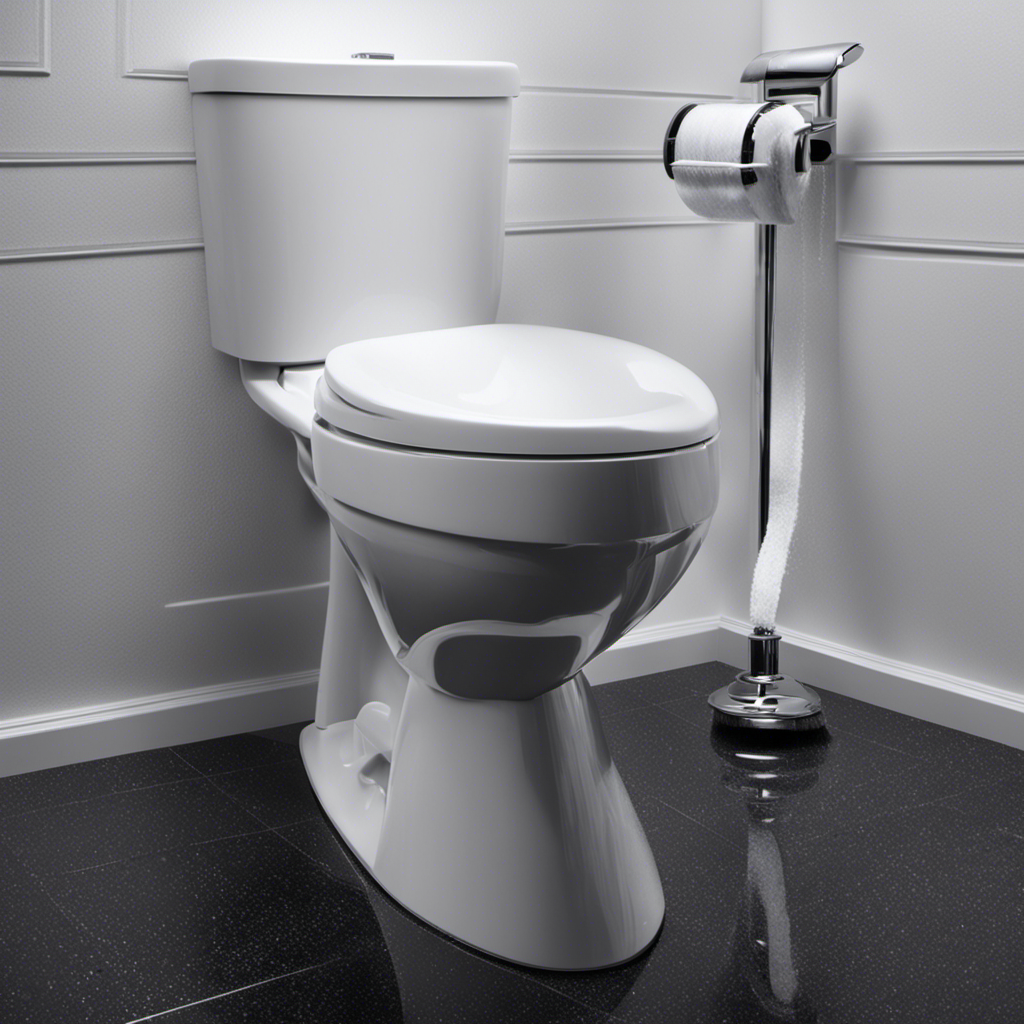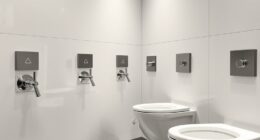Hey there! Ever had the frustrating experience of a clogged toilet? Trust me, I’ve been there too.
But fear not, because I’m here to guide you through the process of opening that stubborn clog and getting your toilet back to its flushing glory.
In this step-by-step article, I’ll walk you through the common causes of toilet clogs, the tools and supplies you’ll need, and the exact steps to take to unclog your toilet.
So let’s dive in and banish those clogs once and for all!
Key Takeaways
- Flushing too much toilet paper at once and flushing non-flushable items are common causes of toilet clogs.
- Using a plunger or a toilet auger can help dislodge the clog.
- If the plunger and toilet auger don’t work, a drain cleaning solution can be used as a last resort.
- Regular maintenance, such as cleaning the toilet and using enzyme-based cleaners, can help prevent toilet clogs.
Common Causes of Toilet Clogs
One of the most common causes of a clogged toilet is when you flush too much toilet paper at once. To prevent this, it’s important to be mindful of how much toilet paper you are using and to flush in small increments.
If you do find yourself with a clogged toilet, there are a few steps you can take for removal.
First, try using a plunger to create suction and dislodge the clog. Place the plunger firmly over the drain hole and push down and then pull up quickly. Repeat this motion several times until the water begins to drain.
If the plunger doesn’t work, you can try using a toilet auger. Insert the auger into the toilet bowl and twist the handle clockwise to break up the clog. Once the clog is removed, flush the toilet to ensure the water drains properly.
Preparing the Tools and Supplies
Before tackling a clogged toilet, it’s important to gather the necessary tools and supplies.
In order to safely and effectively unclog the toilet, you will need a plunger, a toilet auger, rubber gloves, and a bucket.
To ensure your safety, it’s also crucial to take some precautions. This includes wearing protective eyewear and clothing, as well as keeping children and pets away from the area.
Once you have gathered the required tools and taken the necessary safety measures, you can proceed with the step-by-step preparation process to successfully unclog the toilet.
Required Tools and Supplies
To open a clogged toilet, you’ll need a plunger and a pair of rubber gloves. The plunger is a simple but effective tool for unclogging toilets. It consists of a rubber cup attached to a handle.
Before using the plunger, put on the rubber gloves to protect your hands from any potential mess. Next, make sure the toilet bowl is filled with enough water to cover the cup of the plunger. If not, add some water to the bowl.
Position the plunger over the drain hole, ensuring a tight seal. Push down and then pull up on the plunger, creating suction to dislodge the clog. Repeat this motion several times until the water begins to drain.
If the clog persists, you can also try using a drain cleaning solution. However, it’s important to remember to read and follow the instructions on any cleaning solution you use.
Safety Precautions to Take
When using drain cleaning solution, make sure to carefully read and follow the instructions provided to ensure your safety.
Dealing with a clogged toilet can be a messy and unpleasant task, but taking the necessary precautions can help prevent any potential risks. One of the main risks associated with a toilet clog is the possibility of overflowing, which can lead to water damage and unsanitary conditions.
To prevent this from happening, it’s important to avoid flushing excessive amounts of toilet paper or non-flushable items down the toilet. Additionally, regular maintenance such as using a plunger or a toilet auger can help prevent clogs from occurring in the first place.
By following these simple steps, you can minimize the risk of toilet clogs and ensure a smoothly functioning bathroom.
Now, let’s move on to the step-by-step preparation process.
Step-By-Step Preparation Process
First, gather all the necessary supplies for the preparation process. Here is a step-by-step guide to help you prevent and troubleshoot toilet clogs.
| Supplies | |
|---|---|
| Plunger | A plunger is essential for clearing minor clogs. |
| Toilet auger | For more stubborn clogs, a toilet auger can be used. |
| Rubber gloves | Protect your hands from any potential mess. |
| Bucket | Useful for removing excess water from the toilet bowl. |
| Hot water | Boiling water can help break down clogs. |
| Baking soda and vinegar | This combination can be an effective natural clog remover. |
To prevent toilet clogs, remember to avoid flushing anything other than toilet paper down the toilet. Additionally, regular maintenance, such as using enzyme-based cleaners, can help keep your toilet clog-free. When troubleshooting a clogged toilet, start by using a plunger. If that doesn’t work, try using a toilet auger to break up the clog. Finally, if all else fails, a mixture of baking soda and vinegar, followed by hot water, can often do the trick.
Step-by-Step Guide to Unclogging a Toilet
When it comes to unclogging a toilet, there are two main tools that can be used: a plunger or a snake.
Both options have their advantages and it’s important to understand when and how to use each one effectively.
In addition to knowing the right tools for the job, it’s also essential to take preventative measures to avoid clogs in the first place.
Plunger or Snake
To unclog your toilet, grab a plunger or snake and get ready to tackle the blockage. Here’s a step-by-step guide to help you through the process:
-
Assess the water level in the toilet bowl. If it’s too high, use a bucket or cup to remove some of the water until it’s at a manageable level.
-
If you’re using a plunger, position it over the drain hole in the toilet bowl. Make sure it forms a tight seal.
-
Apply downward pressure and start plunging vigorously, using an up-and-down motion. This will create suction and help dislodge the clog.
-
If the plunger doesn’t work, it’s time to use a snake. Insert the snake into the drain hole and slowly rotate it while pushing it further in. This will help break up the clog.
Remember to exercise caution when using a snake to avoid damaging the toilet.
With these tools and steps, you’ll be able to tackle most toilet clogs effectively.
Prevention Tips for Clogs
Now that we’ve covered the different methods to unclog a toilet using a plunger or snake, let’s focus on some prevention tips for clogs.
Proper toilet maintenance can go a long way in avoiding the hassle of dealing with a clogged toilet. Here are some simple DIY unclogging methods you can follow:
-
Regularly clean your toilet: Use a toilet brush and cleaner to remove any buildup and prevent clogs.
-
Avoid flushing non-flushable items: Items like wipes, cotton balls, and sanitary products should be disposed of in the trash, not the toilet.
-
Use less toilet paper: Excessive amounts of toilet paper can cause clogs. Use only what is necessary.
-
Install a drain filter: A drain filter can catch hair and other debris before it enters the toilet drain.
Tips and Tricks for Stubborn Clogs
If you’re dealing with a stubborn clog, try using a plunger to loosen it. Here are some tips and tricks to help you unclog your toilet:
-
Use a plunger: Make sure there is enough water in the toilet bowl to cover the plunger. Position the plunger over the drain, and push down firmly while maintaining a tight seal. Then, pull up quickly to create suction and loosen the clog.
-
Try a toilet auger: If the plunger doesn’t work, a toilet auger can help. Insert the auger into the toilet drain, and turn the handle clockwise to break up the obstruction. Once the clog is loosened, flush the toilet to clear the debris.
-
Call a professional: If your attempts to unclog the toilet fail, it’s time to call in the plumbing professionals. They have the tools and expertise to perform emergency toilet repairs and ensure that your toilet is functioning properly.
Preventing Future Toilet Clogs
One way you can prevent future clogs is by being mindful of what you flush down the drain. Proper toilet maintenance is essential to avoid unnecessary plumbing issues.
Here are some tips for preventing future toilet clogs:
-
Only flush toilet paper: Avoid flushing items like paper towels, wipes, or feminine hygiene products as they can easily clog the pipes.
-
Use less toilet paper: Excessive toilet paper can lead to clogs. Use only the necessary amount to keep the pipes clear.
-
Install a drain strainer: Place a drain strainer over the toilet bowl to catch any debris or hair that may fall in.
-
Regularly clean the toilet: Regular cleaning helps prevent build-up and keeps the toilet functioning properly.
Additional Methods for Opening a Clogged Toilet
Using a plunger is an effective method for clearing a blocked toilet. However, if the plunger doesn’t work or you’re looking for additional options, here are some alternative methods to try:
-
Chemical Solutions: Look for toilet-specific drain cleaners that are safe for your plumbing system. Follow the instructions carefully and use protective gloves. These solutions work by breaking down the clog and clearing the blockage.
-
Hot Water and Dish Soap: Boil a pot of water and mix in a few tablespoons of dish soap. Carefully pour the mixture into the toilet bowl and let it sit for a few minutes. The heat and soap will help break down the clog, making it easier to flush away.
-
Professional Plumbing Services: If all else fails, it may be time to call in the professionals. A trained plumber has the expertise and tools to handle even the toughest toilet clogs. They can quickly diagnose the issue and provide the right solution to get your toilet back up and running.
Frequently Asked Questions
Can I Use a Plunger to Unclog a Toilet?
Yes, you can use a plunger to unclog a toilet. First, make sure there is enough water in the bowl. Position the plunger over the drain and plunge vigorously. If that doesn’t work, try using hot water or a toilet snake.
What Do I Do if the Clog Is Not Resolved After Using a Plunger?
If the clog persists after using a plunger, there are alternative methods to try. You can use a toilet auger or a chemical drain cleaner. If all else fails, it may be time to seek professional assistance.
Can I Use Chemical Drain Cleaners to Unclog a Toilet?
I wouldn’t recommend using chemical drain cleaners to unclog a toilet. They can be harsh on the pipes and harmful to the environment. Instead, try using natural home remedies for unclogging toilets, like a mixture of baking soda and vinegar.
Is It Safe to Use a Toilet Auger Without Any Prior Experience?
Opening a clogged toilet can be a messy and frustrating experience. But is it safe to use a toilet auger without any prior experience? Let’s explore some alternatives and safety precautions.
What Should I Do if the Water Level in the Toilet Bowl Rises After Using a Plunger?
If the water level in the toilet bowl rises after using a plunger, it could mean there’s a blockage further down the pipe. To prevent future clogs, avoid flushing excessive toilet paper and dispose of waste properly.
Conclusion
In conclusion, unclogging a toilet is a task that can be easily tackled with the right tools and knowledge. By following the step-by-step guide provided, you can quickly and efficiently open a clogged toilet and restore normal functionality.
Remember to use caution and take your time to avoid any potential mishaps. With a little patience and perseverance, you’ll be able to tackle even the most stubborn clogs.
So don’t let a clogged toilet ruin your day – take action and get it unclogged!

